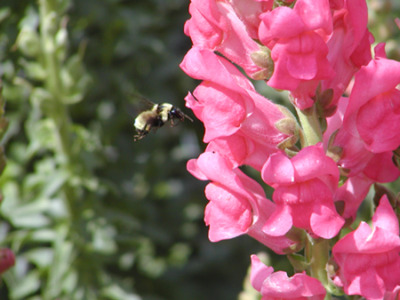
Features
Biocontrols
Inputs
Why bees are such super pollinators
April 22, 2010 By Queen Mary University of London
WEB EXCLUSIVE
Why bees are such super pollinators
Bees see the world almost
five times faster than humans, according to new research from scientists
at
Queen Mary, University of London.

|
| PHOTO CREDIT: DAVE HARRISON, GREENHOUSE CANADA |
April 22, 2010, London, England – Bees see the world almost
five times faster than humans, according to new research from scientists at
Queen Mary, University of London.
This gives bumblebees the fastest colour vision of all
animals, allowing them to easily navigate shady bushes to find food, write Dr.
Peter Skorupski and Prof. Lars Chittka in the Journal of Neuroscience .
The ability to see at high speed is common in fast-flying
insects, allowing them to escape predators and catch their mates mid-air.
However, until now it wasn't known whether the bees' full colour vision was
able to keep up with their high-speed flight. This research sheds new light on
the matter, suggesting that although slower, it is also about twice as fast as
human vision.
Skorupski, who carried out the work at Queen Mary's Research
Centre for Psychology in the School of Biological and Chemical Sciences says
that "we can't easily follow a fast flying insect by eye, but they can
follow each other, thanks to their very fast vision. How fast you can see
depends on how quickly the light-detecting cells in your eye can capture
snapshots of the world and send them to you brain. Most flying insects can see
much quicker than humans, for example, so they can avoid getting swatted!"
Bumblebees use their advanced colour vision in many ways. "Bees
were the first animals that scientists proved to have colour vision, and they
have since been shown to put it to good use,” explains Skorupski, “navigating
dappled light and shady areas, recognizing shapes like their hive entrance, and
particularly for finding nectar-bearing coloured flowers."
The
experiments show that the bees burn more energy to see in colour than they
would to see in monochrome (black and white), raising questions about how they
make the most of it. "Bees' energy can't be used frivolously, as they need
so much of it just to stay alive. It seems they only see colours at half the
speed they see white light, which give them enough detail to find their
favourite flowers and navigate back home," suggests Skorupski.
Print this page